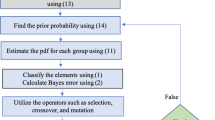Abstract
New feature construction methods are presented. The methods are based on the idea that a smooth feature space facilitates inductive learning thus it is desirable for data mining The methods, Category-guided Adaptive Modeling (CAM) and Smoothness-driven Adaptive Modeling (SAM), are originally developed to model human perception of still images, where an image is perceived in a space of index colors. CAM is tested for a classification problem and SAM is tested for a Kansei scale value (the amount of the impression) prediction problem. Both algorithms have been proved to be useful as preprocess steps for inductive learning through the experiments. We also evaluate SAM using datasets from the UCI repository and the result has been promising.
Access this chapter
Tax calculation will be finalised at checkout
Purchases are for personal use only
Preview
Unable to display preview. Download preview PDF.
Similar content being viewed by others
References
Rendell, L. (1990): Feature construction for concept learning. In Benjamin, D., ed.: Change of representation and inductive bias. Kluwer Academic, 327–353
Murakami, T., et al. (2000): Friendly information retrieval through adaptive restructuring of information space. In: Proc. of AIE/IEA 2000, 639–644
Murakami, T., Orihara, R. (2000): Friendly information retrieval through adaptive restructuring of information space. New Generation Computing 18, 137–46
Blake, C., Merz, C.: UCI repository of machine learning databases. http://www.ics.uci.eduk-mlearn/MLRepository.html (1998)
Morohara, Y., et al. (1995): Automatic picking of index colors in textile pictures for designers. Trans. Inf. Process. Soc. Jpn. 36, 329–337, in Japanese.
Ikeda, M. (1980): Foundation of Color Engineering. Asakura Shoten, in Japanese.
Yamazaki, H., Kondo, K. (1998): A method of changing a color scheme with kansei scales. In: Proc. of 8th International Conference on Engineering Computer Graphics and Descriptive Geometry, 210–214
Muggleton, S. (1987): DUCE, an Oracle based Approach to Constructive Induction. In: Proc. of 10th IJCAI, 287–292
Higuchi, T., et al. (2001): Simplex crossover for real-coded genetic algorithms. Transactions of the JSAI 16, 147–155 in Japanese.
Torkkola, K., Campbell, W. (2000): Mutual information in learning feature transformations. In: Proc. of ICML 2000
Quinlan, J. (1993): C4. 5: Programs for Machine Learning. Morgan Kaufmann
Kira, K., Rendell, L. (1992): The feature selection problem: Traditional method and a new algorithm. In: Proc. of AAAI’92, 129–134
Toshiba Corporation (1997): Data Mining Tool KINOsuite-PR. http://www2.toshiba.co.jp/datamining/index.htm
Author information
Authors and Affiliations
Editor information
Editors and Affiliations
Rights and permissions
Copyright information
© 2002 Springer-Verlag Berlin Heidelberg
About this paper
Cite this paper
Orihara, R., Murakami, T., Sueda, N., Sakurai, S. (2002). Information Space Optimization with Real-Coded Genetic Algorithm for Inductive Learning. In: Abraham, A., Köppen, M. (eds) Hybrid Information Systems. Advances in Soft Computing, vol 14. Physica, Heidelberg. https://doi.org/10.1007/978-3-7908-1782-9_30
Download citation
DOI: https://doi.org/10.1007/978-3-7908-1782-9_30
Publisher Name: Physica, Heidelberg
Print ISBN: 978-3-7908-1480-4
Online ISBN: 978-3-7908-1782-9
eBook Packages: Springer Book Archive




